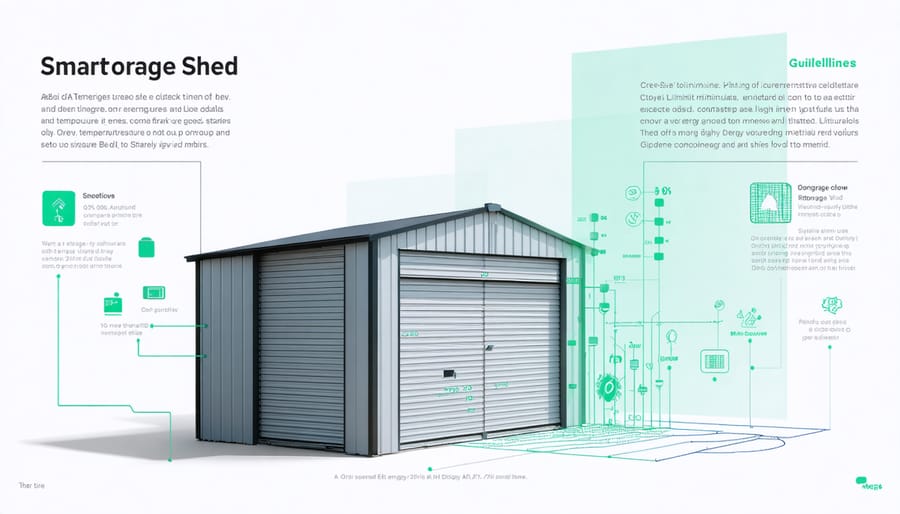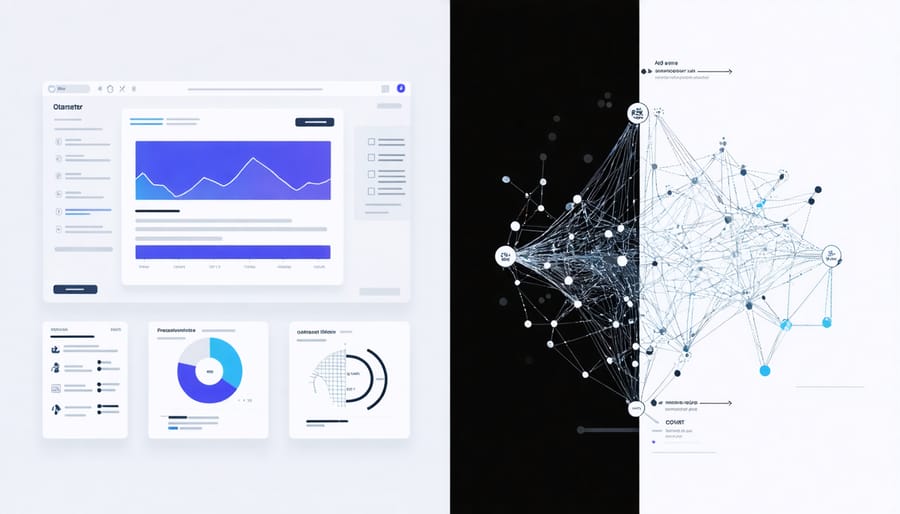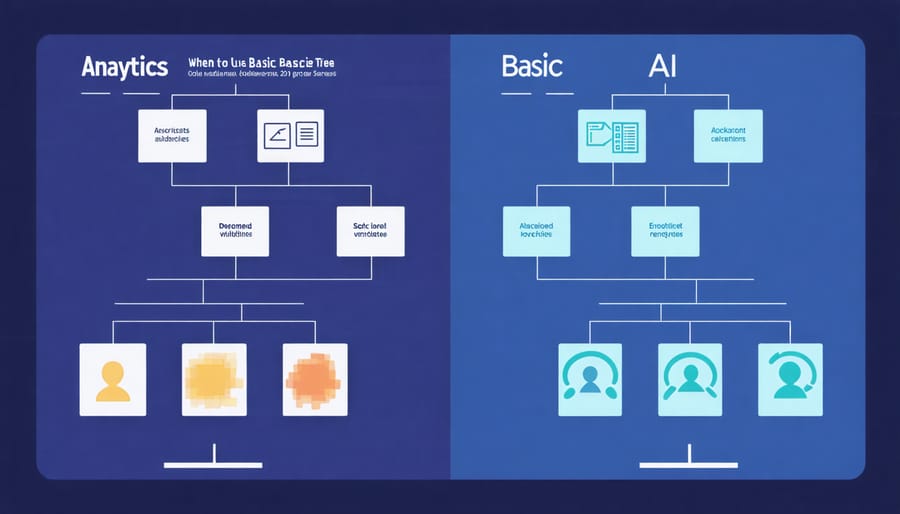AI vs Predictive Analytics: What’s Really Powering Your Shed’s Energy Management

Predictive analytics and artificial intelligence share a fascinating relationship in today’s data-driven world, yet they’re not quite the same thing. While predictive analytics uses historical data patterns to forecast future outcomes, AI encompasses a broader spectrum of machine learning capabilities that can actually learn and adapt from new information. Think of predictive analytics as a specialized tool within the larger AI toolbox – it’s like having a skilled forecaster who excels at spotting patterns, while AI is more like having an entire team of experts who can not only forecast but also make autonomous decisions and discover new insights independently.
For homeowners and property managers looking to optimize their energy management systems, understanding this distinction is crucial. Predictive analytics might help you anticipate your storage shed’s peak energy usage times based on past consumption patterns, while AI could automatically adjust your entire property’s energy systems in real-time, learning and adapting to your unique habits and preferences. This practical difference impacts how you choose and implement smart solutions for your property management needs.
Understanding Predictive Analytics in Shed Energy Management
Key Components of Predictive Analytics
Predictive analytics in shed energy systems relies on three essential building blocks that work together to help you make smarter decisions about your storage space. First, data collection involves gathering information from various sources like temperature sensors, motion detectors, and power meters installed in your shed. These devices continuously monitor how you use energy throughout the day.
The second component, statistical modeling, takes this collected data and makes sense of it. Think of it as creating a mathematical recipe that helps understand patterns in your shed’s energy usage. For example, it might identify that you typically need more lighting during early evening hours in winter months.
Pattern recognition, the third key element, is where the system learns from historical data to spot trends. It can determine when you’re most likely to use certain power tools or when environmental factors like weather might affect your shed’s energy needs. This component helps predict future energy requirements and suggests adjustments to improve efficiency.
Together, these components create a smart system that helps you optimize your shed’s energy use while maintaining comfort and functionality.
Real-World Applications for Your Shed
Modern storage sheds are becoming smarter than ever with smart climate control systems that use predictive analytics to maintain ideal conditions. For temperature control, these systems analyze weather forecasts and historical data to automatically adjust heating and cooling, keeping your stored items safe from extreme temperatures. This is particularly useful for protecting temperature-sensitive items like gardening supplies or power tools.
Lighting systems can learn your usage patterns and automatically illuminate the shed when you typically access it. They can even adjust brightness based on the time of day and natural light levels, helping you save on energy costs while ensuring visibility when you need it.
Ventilation is another area where predictive analytics shines. By monitoring humidity levels and air quality, smart systems can activate fans or dehumidifiers before moisture becomes a problem. This proactive approach helps prevent mold growth and protects your belongings from moisture damage. These practical applications make your shed more functional and efficient, while potentially extending the life of both the structure and its contents.

The AI Connection: Where Machine Learning Fits In

Machine Learning vs Traditional Analytics
When comparing traditional analytics with machine learning approaches, think of it like the difference between following a recipe book and having a chef who learns from experience. Traditional analytics relies on pre-set rules and historical patterns to make predictions. It’s like using fixed formulas to calculate future outcomes based on what happened in the past.
Machine learning, on the other hand, continuously learns and adapts from new data. It can spot complex patterns that might not be obvious to human analysts and adjust its predictions accordingly. While traditional analytics might struggle with unexpected changes or new variables, machine learning systems can quickly adapt to shifting conditions.
For example, in energy management, traditional analytics might use simple averages of past usage to predict future consumption. Machine learning goes further by considering multiple factors like weather patterns, occupancy schedules, and equipment performance to make more accurate predictions. It can even learn from its mistakes and improve over time.
However, this doesn’t mean traditional analytics is obsolete. Many businesses still benefit from simpler analytical approaches, especially when dealing with straightforward predictions or when transparent, easily explainable results are needed. The key is choosing the right tool for your specific needs, whether that’s the reliability of traditional methods or the advanced capabilities of machine learning.
Smart Features That Make a Difference
Modern storage sheds are getting smarter thanks to AI-powered energy optimization features that truly make a difference in both functionality and efficiency. These intelligent systems learn from your usage patterns to automatically adjust lighting and temperature controls, ensuring your shed maintains optimal conditions while minimizing energy waste.
Motion sensors work in harmony with smart lighting systems to illuminate specific areas only when needed, while automated ventilation systems respond to temperature and humidity changes to protect your stored items. What’s particularly impressive is how these features adapt over time – they remember when you typically access your shed and prepare the environment accordingly.
The smart thermostat function is especially noteworthy, as it maintains ideal temperatures for sensitive equipment or materials while reducing energy consumption during periods of low activity. For DIY enthusiasts storing power tools, the system can even monitor and alert you about potential moisture issues that could affect your equipment.
These features aren’t just about saving energy – they’re about making your storage space work smarter for you. Many users report significant improvements in organization and accessibility, with some noting up to 30% reduction in their shed’s energy usage after implementing these smart solutions.

Choosing the Right Solution for Your Storage Shed
When Basic Predictive Analytics Is Enough
While advanced AI systems can be impressive, many everyday prediction tasks can be handled effectively with basic predictive analytics. For example, if you’re tracking temperature patterns in your storage shed to optimize climate control, simple statistical methods can provide reliable forecasts based on historical data.
Traditional predictive analytics works particularly well when you have clear patterns and straightforward relationships in your data. If you notice your shed’s temperature rises consistently between 2-4 PM during summer months, basic trend analysis can help you plan cooling interventions without needing complex AI algorithms.
These simpler solutions are often more cost-effective and easier to implement. They work best when:
– You have consistent, predictable patterns
– Your data is relatively clean and structured
– You’re dealing with a limited number of variables
– The relationships between factors are straightforward
– You need quick, actionable insights
For instance, tracking seasonal humidity levels in your shed to protect stored items doesn’t require sophisticated AI. A basic predictive model can analyze past humidity data and weather patterns to forecast when you might need additional ventilation or dehumidification.
The key is matching the complexity of your solution to your actual needs. Sometimes, a straightforward approach using basic predictive analytics can provide all the insights you need while being more maintainable and cost-effective than a full AI system.
When to Invest in AI-Enhanced Systems
Investing in AI-enhanced systems becomes particularly valuable when your storage needs grow more complex or when you’re managing multiple structures. These advanced solutions really shine when you need to track multiple variables simultaneously, like temperature, humidity, and security across several storage units. For example, if you’re storing sensitive equipment or valuable items that require precise environmental control, predictive maintenance capabilities can help prevent costly damage before it occurs.
Consider upgrading to AI-enhanced systems when you notice recurring issues that basic analytics can’t solve, such as persistent moisture problems or unexpected temperature fluctuations. These systems excel at identifying subtle patterns that might escape human observation, making them invaluable for protecting high-value items or maintaining optimal storage conditions year-round.
AI solutions are also worth considering when you need to automate complex decision-making processes. For instance, if you’re managing climate control across multiple storage units with different requirements, AI can automatically adjust settings based on weather forecasts, usage patterns, and stored item specifications. This level of sophistication goes beyond simple predictive analytics, offering more precise control and better protection for your stored belongings.
As we’ve explored throughout this article, predictive analytics and AI are closely intertwined but distinct technologies that can significantly benefit shed owners looking to optimize their storage spaces. While predictive analytics uses historical data to forecast future trends, AI takes these capabilities further by learning and adapting to new situations autonomously.
For shed owners, this relationship means more intelligent and efficient storage solutions. You can start small by implementing basic predictive analytics tools to monitor temperature and humidity levels, then gradually incorporate AI-powered systems as your needs grow. This stepped approach allows you to build a smart storage solution that fits your specific requirements and budget.
Here are some practical takeaways to get you started:
1. Begin with simple monitoring systems that track basic environmental conditions
2. Use data collected over time to identify patterns in your storage needs
3. Consider weather-responsive automation for ventilation and climate control
4. Implement smart security features that learn from daily usage patterns
5. Regular system updates to improve prediction accuracy and performance
Remember, you don’t need to implement everything at once. Start with the features that address your most pressing storage challenges, then expand as needed. Whether you’re storing seasonal decorations, gardening equipment, or valuable tools, the combination of predictive analytics and AI can help create a more efficient, secure, and comfortable storage environment.
By understanding how these technologies work together, you can make informed decisions about which solutions best suit your shed’s needs while ensuring your investment delivers long-term value and functionality.

